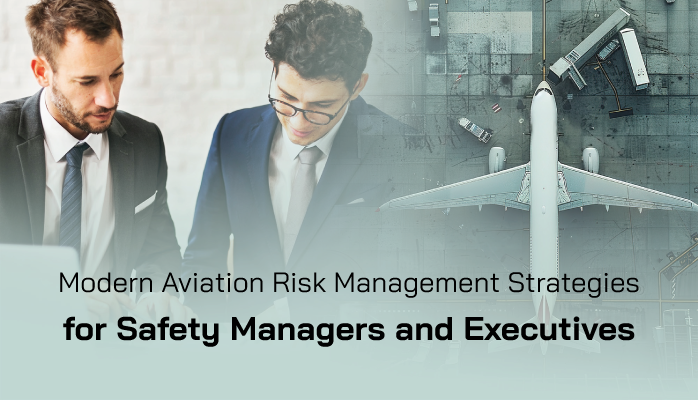Modern Aviation Risk Management Strategies

Aviation safety is paramount in an industry where even minor oversights can lead to catastrophic consequences. For aviation safety managers and accountable executives, implementing robust risk management strategies is not just a regulatory requirement but a moral imperative.
Modern aviation risk management has evolved significantly, leveraging technology, data analytics, and proactive methodologies to enhance safety outcomes. This article explores cutting-edge strategies to help aviation professionals mitigate risks, ensure compliance, and foster a culture of safety.
Understanding Aviation Risk Management
Aviation risk management is the systematic process of identifying, assessing, and mitigating risks that could compromise the safety of flight operations, ground activities, or organizational processes. It aligns with frameworks like the International Civil Aviation Organization (ICAO) Safety Management System (SMS) and regulatory requirements from bodies such as the Federal Aviation Administration (FAA) and European Union Aviation Safety Agency (EASA).
The core components of an effective aviation risk management program include:
- Hazard Identification: Recognizing potential threats, from mechanical failures to human factors.
- Risk Assessment: Evaluating the likelihood and severity of risks.
- Risk Mitigation: Implementing controls to reduce or eliminate risks.
- Monitoring and Review: Continuously assessing the effectiveness of risk controls.
Modern strategies build on these foundations, integrating advanced tools and proactive monitoring approaches to stay ahead of emerging risks.
Related Aviation Risk Management Articles
- Most Common Aviation Risk Management Challenges at Airlines & Airports
- What Is Proactive Risk Management in Aviation SMS?
- How SMS Pro Ensures FAA Part 5 Risk Management Compliance for Aviation Safety
1. Leveraging Data-Driven Risk Identification
Data is the backbone of modern aviation risk management. The proliferation of digital systems in aircraft, air traffic control, and maintenance operations generates vast amounts of data that can be harnessed to identify hazards before they escalate.
Flight Data Monitoring (FDM)
Flight Data Monitoring, also known as Flight Operations Quality Assurance (FOQA), involves analyzing flight data to detect trends or anomalies. For example, FDM can identify unstable approaches, excessive descent rates, or deviations from standard operating procedures (SOPs). By integrating FDM into the SMS, safety managers can proactively address issues.
Actionable Tip: Invest in FDM software that integrates with your fleet’s avionics systems. Ensure analysts are trained to interpret data and translate findings into actionable safety improvements.
Predictive Analytics
Predictive analytics uses machine learning to forecast potential risks based on historical data. For instance, analyzing maintenance records alongside weather data can predict component failures under specific conditions. Airlines like Delta and Lufthansa have adopted predictive maintenance to reduce unscheduled downtime. SMS Pro includes predictive features that learn from your organization's historic risk management activities.
Actionable Tip: Partner with analytics providers to develop custom models tailored to your operational environment. Start with pilot projects to validate predictive models before full-scale implementation.
2. Enhancing Human Factors Analysis
Human error remains a leading cause of aviation incidents. Modern risk management emphasizes understanding and mitigating human factors through advanced training, fatigue management, and psychological support.
Just Culture
A Just Culture encourages employees to report safety concerns without fear of punitive action, fostering transparency. This approach is critical for identifying latent hazards, such as procedural non-compliance or inadequate training.
Actionable Tip: Develop a clear Just Culture policy that outlines when disciplinary action is warranted versus when learning opportunities are prioritized. Train managers to handle reports consistently and fairly.
Fatigue Risk Management Systems (FRMS)
Fatigue impairs decision-making and reaction times, posing significant risks. FRMS uses scientific principles to monitor and manage crew fatigue, incorporating tools like biomathematical models to predict fatigue levels based on duty schedules.
Actionable Tip: Implement FRMS software that integrates with crew scheduling systems. Regularly review fatigue reports and adjust rosters to minimize high-risk scenarios.
Related Fatigue Risk Management Articles
- 3 Ways for Dealing With Fatigue Risk Management in Aviation SMS
- How to Best Monitor Fatigue in Your Aviation SMS
- Winter Fatigue Hazard Register Review - Aviation SMS SRM & SA Example
3. Integrating Safety Management Systems (SMS)
The ICAO mandates SMS for aviation organizations, but modern SMS implementations go beyond compliance to drive continuous improvement. A mature SMS integrates risk management into all organizational levels, from frontline staff to executives.
Aviation SMS Software Solutions
Cloud-based SMS platforms, such as Aviation Safety Management Software from providers like SMS Pro or ABC, streamline hazard reporting, risk assessments, and audit management. These tools enable real-time tracking of safety performance indicators (SPIs).
Actionable Tip: Select an SMS platform with customizable dashboards and mobile accessibility to ensure all stakeholders can engage with the system. Train staff regularly to maximize adoption. SMS Pro is trusted worldwide.
Related Aviation Safety Software Articles
- How to Choose Aviation SMS Software - Educating SMS Professionals
- How to Choose the Best Aviation Safety Database Software
- 20 Benefits of Aviation SMS Software
Safety Performance Indicators (SPIs)
SPIs measure the effectiveness of safety controls, such as the frequency of runway incursions or maintenance errors. Modern SMS emphasizes leading indicators (e.g., training completion rates) over lagging indicators (e.g., incident rates) to predict risks.
Actionable Tip: Define SPIs that align with your operational risks. Review them quarterly to ensure they remain relevant and drive proactive interventions.
4. Adopting Advanced Technology for Risk Mitigation

Technology is transforming aviation risk management, offering tools to enhance situational awareness, automate processes, and improve decision-making.
Unmanned Aircraft Systems (UAS) and Drones
Drones are increasingly used for inspections, such as checking aircraft for structural damage or monitoring airport perimeters. They reduce the need for hazardous manual inspections and provide high-resolution data.
Actionable Tip: Develop a drone operations program with trained pilots and clear SOPs. Ensure compliance with local regulations, such as FAA Part 107 in the U.S.
Artificial Intelligence (AI) in Air Traffic Control
AI-powered systems assist air traffic controllers by predicting potential conflicts and optimizing traffic flow. For example, NASA’s Airspace Technology Demonstration 2 (ATD-2) uses AI to reduce taxi times and enhance safety.
Actionable Tip: Collaborate with air traffic service providers to integrate AI tools into your operations. Advocate for industry-wide adoption to maximize benefits.
5. Building a Proactive Safety Culture
A strong aviation safety culture is the foundation of effective risk management. It requires leadership commitment, employee engagement, and continuous communication.
Leadership Commitment
Accountable executives must champion safety by allocating resources, setting clear expectations, and modeling safe behaviors. Regular safety briefings and visible support for SMS initiatives reinforce this commitment.
Actionable Tip: Schedule quarterly safety town halls where executives share updates on risk management initiatives and recognize employee contributions to safety.
Employee Engagement
Engaging frontline staff in risk management activities ensures hazards are identified early. Tools like anonymous reporting apps and safety suggestion programs empower employees to contribute.
Actionable Tip: Launch a safety recognition program to reward employees who identify significant hazards or propose effective mitigations. Publicize success stories to encourage participation. SMS Pro contains features allowing managers to nominate employees for safety contributions.
Related Aviation Safety Culture Articles
- 3 Reasons Why Aviation Safety Culture Leads Directly to Safety Performance
- How to Trend Safety Culture Using Safety Reporting System
- 5 Characteristics of Effective Aviation Safety Cultures - With Free Survey
6. Addressing Emerging Risks
The aviation industry faces new challenges, from cybersecurity threats to climate-related disruptions. Modern risk management requires agility to address these evolving risks.
Cybersecurity in Aviation
As aircraft and ground systems become more connected, cybersecurity risks grow. A single breach could compromise navigation systems or operational data.
Actionable Tip: Conduct regular cybersecurity audits and train staff on phishing and social engineering threats. Partner with IT specialists to implement robust firewalls and encryption protocols.
Climate Change Impacts
Extreme weather events, such as hurricanes and heatwaves, disrupt operations and increase risks like runway excursions. Risk management must account for these environmental factors.
Actionable Tip: Update risk assessments to include climate-related hazards. Invest in weather monitoring systems and train crews to handle extreme conditions.
7. Continuous Improvement Through Audits and Feedback
Regular audits and feedback loops ensure risk management strategies remain effective. Internal and external audits identify gaps, while feedback from staff and passengers provides real-world insights.
Internal Audits
Internal audits assess SMS compliance and operational risks. They should be conducted by trained auditors independent of the processes being evaluated.
Actionable Tip: Use audit management software to streamline planning, execution, and follow-up. Share findings with all stakeholders to drive accountability. SMS Pro maintains robust auditing features suitable for small to large operators.
Related Aviation Safety Audit Articles
- Aviation Safety Audits 101: Prep and Pass - With Examples and Checklists
- How to Create an Aviation SMS Audit Plan
- 4 Tips for Passing Aviation SMS Audits - With Free Resources
Passenger and Stakeholder Feedback
Passenger complaints and stakeholder input can highlight risks, such as confusing signage or inadequate emergency procedures.
Actionable Tip: Implement a feedback portal on your website and analyze trends quarterly. Address recurring issues promptly to enhance safety and customer satisfaction.
Conclusion
Modern aviation risk management is a dynamic, multifaceted discipline that combines data analytics, technology, and human factors to safeguard operations. By leveraging tools like FDM, predictive analytics, and SMS software, safety managers and executives can proactively mitigate risks.
Building a Just Culture, integrating advanced technologies, and addressing emerging threats like cybersecurity and climate change further strengthen safety outcomes.
For aviation safety professionals, the journey toward zero incidents requires continuous learning and adaptation. Start by assessing your current risk management practices, investing in training, and fostering a culture where safety is everyone’s responsibility. By embracing these modern strategies, you can ensure your organization not only meets regulatory standards but sets a benchmark for aviation safety excellence.
Call to Action: Review your SMS implementation today. Identify one area—such as FDM or fatigue management—where you can adopt a modern tool or practice. Small, targeted improvements can yield significant safety dividends.








